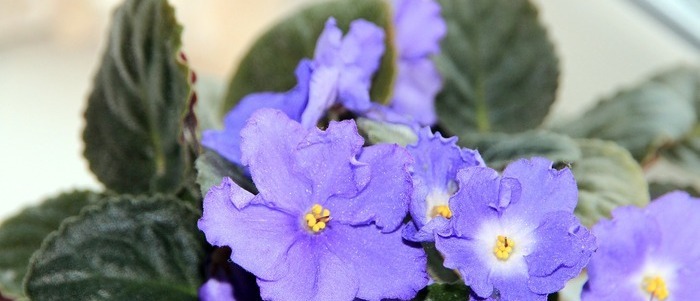Who wouldn’t love to have sweet, charming fuzzy-leaved Blue African Violet Plant in their home? Well, that would be almost all of us, especially if your outdoor landscape seems bare and brown. And if you have a list of “favorite houseplants,” then the Blue African violet plant is bound to be among the top. And why not? It’s easy to care for, blooms reliably and profusely, and is a mystique plant from native Africa.
Now, if you are an indoor gardener and thinking of getting some more Blue African violet plants for your home or planning to gift your mother one, then this article is just for you. In this article, we are going to talk about how to take care, propagate and prune your favorite houseplant easily.

Blue African Violet Frequently Asked Questions
Do African violets like sun or shade?
African violets prefer bright, indirect light. Direct sunlight can burn their leaves and cause damage. If you're keeping your African violet indoors, place it near a window that receives filtered light or use a sheer curtain to filter the light. Outdoors, they can be grown in a shaded area or under a tree canopy. It's important to note that too little light can also affect the growth and flowering of African violets, so finding the right balance is key
How do I get my African violet to bloom?
To encourage blooming, make sure your African violet is receiving the right amount of light and is not being over or underwatered. Fertilize regularly with a balanced fertilizer and make sure the soil is well-draining. You can also try adjusting the temperature, as African violets prefer slightly cooler temperatures (around 65-75°F) to encourage blooming. Finally, be patient – it can take several weeks or even months for an African violet to produce blooms.
Tips for Taking Care of Blue African Violet Plant
Are you thinking of learning to grow these cheerful bright blooming African violets in your indoor space? Well, one of the greatest advantages of growing this plant is it takes very little space, and growing them in small pots makes for a showy display. Just follow the below-mentioned tips and give them a shot if you are thinking of indoor growing:
- Light: Light intensity for the Blue African Violet Plant has to be filtered and should be medium to bright. Remember, lighting affects flowering. African violet plants with medium to pale green foliage need less lighting than the ones with deeper green foliage.
- Water: Remember to water the base of the plant rather than splashing the foliage. Also, water only when the soil feels dry. Proper watering is extremely important when it comes to African violets. They should never be allowed to dry out completely or stand in water.
- Soil: Potting the plant in the right mix of soil is necessary for Blue African Violet Plant. There are special mixes available in the market like perlite, vermiculite, and peat moss. Mix these in equal proportions to form the perfect soil for your plant.
- Fertilizer: Blue African Violet Plants need special food or fertilizers that are high in phosphorus. Just mix one-quarter of the fertilizer every time you water the plant. Pale leaf color and reduced flowering indicate that the plant isn’t getting enough food.
Propagating The Blue African Violet Plant
Propagating Blue African Violet Plant is easy. Just follow the following 10 steps:
- Step 1: Prepare the rooting medium by mixing one part potting mix with two parts perlite.
- Step2: Add just enough water with the rooting medium to form a clump
- Step 3: Fill the pots with the rooting medium and then poke few holes in the soil
- Step 4: Choose healthy and mature leaves from the original plant
- Step 5: Prepare the leaves by shortening the stems of the leaves
- Step 6: Wear proper eye protection and gloves while applying rooting hormone
- Step 7: Place each of the leaves stems firmly and upright in the rooting medium
- Step 8: Use the plant tags as stands to ensure the leaves stand properly
- Step 9: Place the pots carefully in a lid tight container
- Step 10: After about eight weeks, transfer the plants into proper-sized containers
The above-mentioned steps will make caring for your Blue African Violet Plant easy, and propagating them will seem like a pleasure.
Pruning The Blue African Violet
African Violets, although they might seem like an old-fashioned plant for most people they are an extremely popular indoor plant. Their perfect small size, soft furry leaves, and intensely bright colored blooms can brighten any corner of your living space instantly. An easy way to make the African Violet look perfect and more beautiful is by trimming it. Trimming, although it might seem like a complicated task, is an easy one and require very little time and skill.
One of the main reasons why pruning might seem like a huge task is because we are reminded of the huge bladed cutting equipment used on shrubs or trees. Well, worry not because you will not need such heavy-duty implements. This is mainly because Blue African Violets have very soft stems that need lighter means for trimming. All one needs is fine-tipped scissors, or simply your fingernails can do the magic.
While pruning the Blue African Violets, just make sure that you are removing only the damaged or dead leaves and the withered flowers. Consider this as a beauty regimen of your indoor plant. Cutting off the dead and damaged parts will help fresh air and light to reach the new growth. And the best part is you can do this at any time of the year, unlike some other plants that can be trimmed only during a certain time of the year.
How to Perfectly Prune the Blue African Violet Plant
If you want to see the Blue African Violet as healthy as possible, then prune only around three bottoms leaves each month. This plant’s leaves grow regularly, and pruning will balance out the visibility of the violets while also allowing room for the new leaves. Removing spent flowers regularly is also important as this will help to promote new blooms. This is because the plant doesn’t have to direct its energy towards the old flowers. And that’s not all this will also enhance the appearance of the plant while at the same time encouraging airflow.
One easy way of pruning the African Violet Plant is pinching off the flower or leaf using your thumb and forefinger. Use sterilized scissors to remove the plant material closest to the base, making sure that you don’t cut into the primary stem. If you are thinking of planting new Blue African Violets, then remove some of the healthy basal leaves of the plant. African violets being very forgiving plants; they will not mind at all. This will help improve the appearance of the plant immensely.
Just fill in a small pot with some moistened, well-drained African violet soil, and then insert the leaf stem. For support, use toothpicks to support the leaf above water. And then all you have to do is wait for a couple of weeks to see the new leaves and the beautiful, beguiling flowers bloom.













